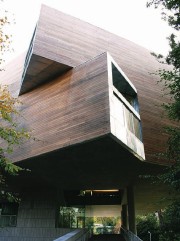York heat pumps at heart of geothermal heating and cooling system

A geothermal system serving the Lewis Glucksman Art Gallery at University College, Cork, enables heating and cooling to be provided at the same time using two York water-cooled heat pumps.
A geothermal combined heating and cooling system for the Lewis Glucksman Art Gallery at University College in Cork is served by two heat pumps supplied by York International. This gallery requires a highly controlled environment for the preservation and safe keeping of its art collections. Building-services consultant Arup selected a range of climate-control technologies to meet the requirements of each viewing space, while optimising energy efficiency. The main source of heating and cooling is a ground-energy thermal-transfer system. Thermal-energy specialist Dunstar supplied its GCHC system, which enables a liquid chiller installation to serve as a full service heat source simultaneously with its refrigeration function. Two York water-cooled heat pumps generate chilled water at 6°C and heating water at 45°C at the same time. Heat rejected from the cooling process is fed directly into the heating circuits. Excess heat or cooling is transferred to the ground water via a plate heat exchanger. The ground water is sourced from two 12 m-deep boreholes and discharged to a holding tank for flushing toilets and landscape irrigation. Excess water is discharge into the adjacent River Lee. Chilled water and heating water is fed to air-handling units in mezzanine plantrooms in each gallery. The entire building-services system is designed to minimise noise intrusion into the gallery space, have no impact on the external appearance of the building and maximise energy efficiency. This art gallery was designed by architects O’Donnell & Tuomey and built into the natural surrounding of the River Lee. It has already won awards from CIBSE, RIAI and RIBA and been short-listed for the 2005 RIBA Stirling Prize for architecture.
Related links:


